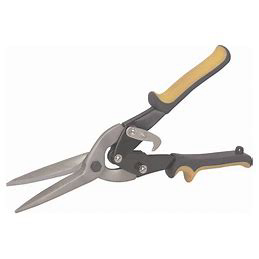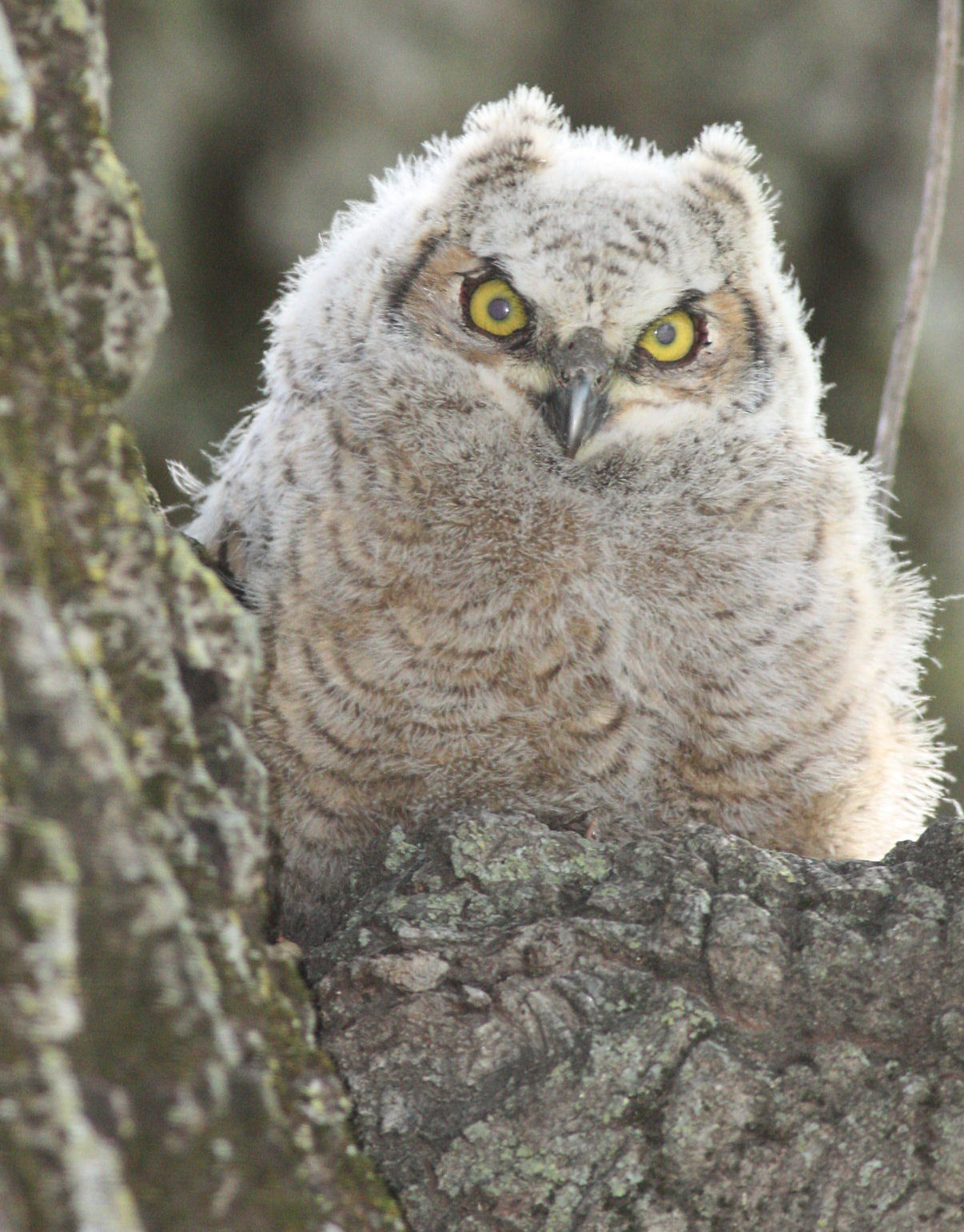
Although Great Horned Owls aren’t typically thought of as “backyard birds,” many birders live in rural areas, or have contact opportunities with land managers at nature centers or refuges where an owl nesting cone would be welcomed (photo by Paul Konrad).

Building an artificial stick nest for Great Horned Owls is easy, you just need a 3x3 foot square of wire mesh, a tin snips, a side-cutting pliers, a wire coat hanger, and a pile of sticks.

Seeing a downy Great Horned Owl perched on a branch on the edge of its nest site in tree is the ultimate payback for providing a new nest site (photo by Paul Konrad).
|
Did you know that owls don’t build nests? Owls either nest in a cavity, the open end of a snag, or they take over another bird’s nest; like a nest built by a hawk, magpie, or raven. But some owls take advantage of nest boxes, ranging from small nest boxes for screech owls or pygmy owls, and some larger owls including Barred Owls and Barn Owls. While it’s easy to buy or build an appropriately sized nest box for the above species and others, Great Horned Owls don’t nest in cavities or nest boxes, but prefer to take over hawk nests.
A favorite nest for Great Horned Owls across North America is a nest built by a pair of Red-tailed Hawks. The similarly sized hawks usually build well-constructed substantially sized stick nests that tend to be built securely in the crotch of a tree, where it can withstand strong wind storms. Because they lay eggs as much as a month before any hawks, Great Horned Owls tend to get their pick of nests in an area where a pair chooses to nest. This might displace a pair of hawks that prefers a given nest site year after year, but many hawks build a new nest annually, so there are some “spare” nests, and if an owl takes over a hawk nest of a resident pair, the hawks are forced to build a new nest, sometimes within sight of the incubating owl.
Positioning an Owl Nest Cone
Building the nest is the easy part, but first let’s address where to place the nest. First, you need owl habitat – a tree or group of trees located at the edge or interior of a hayfield is best, because hayfields tend to be populated by pocket gophers and meadow voles, 2 primary Great Horned Owl prey animals.
Next, look among the trees in the area for one that has a “crotch” with branches radiating from the trunk that will hold the artificial nest you are planning to build. The crotch should be 20 to 45 feet high where the nest cone will fit snugly. We will address installing the artificial nest below.
Building a Nest for Great Horned Owls
Today we know that you can attract a pair of Great Horned Owls to a given location where they find populations of pocket gophers, meadow voles, and other small rodents that they catch during the semi-darkness of night. In some cases you may be providing the only nest site in an area where there were no large stick nests available, thereby eliminating a limiting factor for Great Horned Owls. And who knows, a pair of hawks may build atop your “artificial” nest, that could happen too, or another species of owl might be attracted to it, such as a pair of Barred Owls or Great Gray Owls – if you live within the range of these species.
It’s easy to build a stick nest for a Great Horned Owl pair (or a pair of a similar-sized owl or hawk species). You will need a couple simple items: A 3x3 foot square of 1-inch mesh wire and a metal-cutting “scissors,” which you can get at almost any hardware store or farm supply store, along with a wire clothes hanger or another length of stout wire, and a side-cutting pliers. And that’s really the only material and tools you need, aside from a collection of branches and sticks – simple enough.
First, cut a wire clothes hanger or another piece of wire into pieces a couple inches long that you can use to hold 2 sides of the wire sheet together. Next you will fashion a cone-shaped form out of the sheet of wire mesh: Cut the thin metal starting at one corner and angling on a straight line to the center of the square sheet of wire. Then carefully overlap one side of the cut wire sheet over the other side to form a cone with a circular top and a pointed bottom.
To hold the wire cone in position, use the short pieces of wire hanger to fasten the wire in position using the side-cutting pliers to bend and cut the wire. You can also try weaving the wire along portions of the overlap to hold the wire edges in position between the point at the bottom and the ends of the wire sheet at the top of the cone. Once your wire cone feels stable, you’re done.
That’s when you begin nest building. Begin filling the cone with large twigs and small tree branches, mostly on a horizontal angle, criss-crossing some and making a platform in the process. By the time you have filled the cone with sticks, your owl nest is mostly complete. At the top, we like to add a layer of grass or hay in the center to provide a bit of a padded depression where the female owl can lay her eggs with a level of insulation below them.
Installation
Now comes the harder part of the process – installing the nest cone into a crotch in a tree that is supported by branches on each side. NestWatch suggests the nest should be positioned between 15 and 45 feet high, but from our experience 15 feet may be a bit low – 20 to 30 feet high is a good range, higher if you are able. To raise the nest cone into position, some birders are able to throw a rope over a sturdy branch above the nest site, then lift the nest into position. Others call an arborist or get some construction-level help to lift the nest cone into the crotch of a tree.
Keep the wire cutters handy during the installation process, because if the point of the cone is to sharp, you can bend or cut the bottom portion of the wire to help make the nest cone fit snugly into the crotch. Once the nest is in position, you’re ready for owls to begin inspecting the nest and considering it as a nest site.
At that point, patience is your greatest virtue, as it can take a year or more for a pair of Great Horned Owls to take over the nest, but imagine the level of excitement that will bring, and the level of satisfaction if owls raise nestlings and fledge young from your new nest site! It’s really an aspect of bird conservation that is underestimated at times.
You can access a PDF worksheet that shows the NestWatch directions for building a Great Horned Owl nest cone at great-horned-owl.pdf (nestwatch.org) And you can learn more about nesting Great Horned Owls at NestWatch | Great Horned Owl - NestWatch
As noted in the first paragraph, it's fairly easy to buy or build a nest box for cavity nesting owls – small or large – and an excellent outlet for you to check out a variety of nest boxes for owls is BestNest; see Owl & Kestrel Houses at BestNest!
Share your backyard birding experiences and photographs with The Birding Wire at editorstbw2@gmail.com